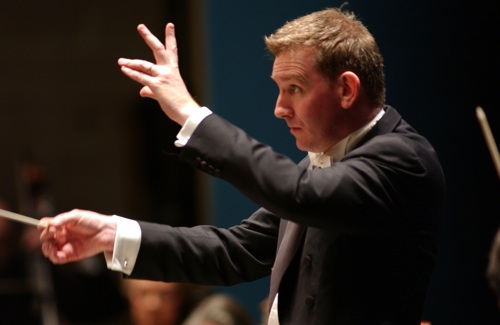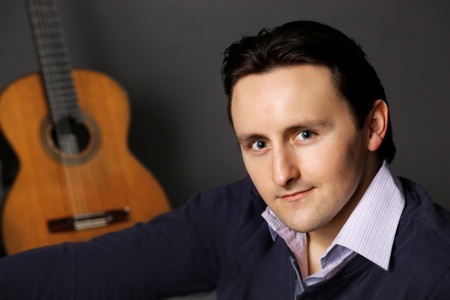North Bay Symphony promises…
Led by Alasdair Neale, the Marin Symphony delivered a solid and entertaining show last Sunday, Feb. 28, at the Marin Center Veteran’s Memorial Auditorium. In the 15 years that Neale has been their Music Director, this orchestra has established its reputation, and this week they polished that.
Alasdair prefaced the concert, giving a nod to the other event of the evening. “Thank you for attending this Academy Awards ‘pre-show.’ Don’t worry. This program is not that long and you should be back in time to make… comments on the stars and see how gorgeous everyone looks.” (laughter) “This is a program of dark waters. It reminds us that great art can probe deep, and offer you questions and perhaps answers. We begin with Brahms’ Tragic Overture, a big, rich and substantive piece.”
 Two massive chords set the mood. Brahms was at the height of his harmonic powers, and those chords were as rich as promised, altering internally to create a heart-in-mouth mood. The orchestra was rounded yet incisive, a sure sign of what was to come. And they did deliver: a sense of certainty and development that was pure Beethoven, but with Brahms’ love of nature in all its storm.
Two massive chords set the mood. Brahms was at the height of his harmonic powers, and those chords were as rich as promised, altering internally to create a heart-in-mouth mood. The orchestra was rounded yet incisive, a sure sign of what was to come. And they did deliver: a sense of certainty and development that was pure Beethoven, but with Brahms’ love of nature in all its storm.
The mood turned woodsy, with lovely flute passages from Monica Daniel-Barker and an ostinato of sixteenths in the strings. That theme moved to the oboes and then the horns and swelled into a lush statement, closer to what one thinks of with Brahms. It was big boned, regal, and solid.
This was a quick descent into deep waters, but then the program turned to the golden sun of Spain. Joaquín Rodrigo is best known for his Concierto de Aranjuez, a romance for guitar and small orchestra that he unveiled in 1939 when he returned to Spain after a decade in France. Guest soloist Robert Belinic was the guitarist, and brought the nimble runs and impetuous force of youth to his playing. But he also brought melancholy, perhaps relating to the haunting of Spain’s past. For 1939 was also the year that the Spanish Civil War came to its bloody end as Franco took power in Madrid and the same year that Hitler invaded Poland. It was a difficult time for Rodrigo to return to his homeland, but the beauty and depth of the work won him a place in the hearts of a divided people.
 Belinic brought steel and restraint, and flute warbles added birds and a rustic mystery. The orchestration reflected Rodrigo’s sojourn in France, fanciful and coloristic, but with the slap and steel of Flamenco. In the second movement guitar joined with English horn – and Laura Reynolds was a standout here – in a duet that was deeply felt, regretful almost to the point of bitterness. Belinic added belling low notes, then moved into brighter cadenzas with Flamenco flair.
Belinic brought steel and restraint, and flute warbles added birds and a rustic mystery. The orchestration reflected Rodrigo’s sojourn in France, fanciful and coloristic, but with the slap and steel of Flamenco. In the second movement guitar joined with English horn – and Laura Reynolds was a standout here – in a duet that was deeply felt, regretful almost to the point of bitterness. Belinic added belling low notes, then moved into brighter cadenzas with Flamenco flair.
The Romance ended with a folk (or folksy) melody, strangely jaunty after the Iberian melancholy, but it was an opportunity to party! A full audience gave long applause to the flair of the young guitarist and the tight entrances of the reduced orchestra.
… and delivers.
After intermission we turned from the warmth of Valencia back to the deep romanticism of Brahms. His Symphony No. 4 is one of his best-known works, and Neale led a sumptuous performance. He turned to us again with remarks.
“I’d like to interject a personal note here. My teacher, Otto Werner-Mueller, died this past Friday at the age of 90. I’d like to dedicate this performance to him. He was a towering presence, even if he was 6’7” tall, and he would have towered at any height… He was what you’d call ‘old school’ – he despised superficiality and glitz, but embraced the musical essence. I learned this piece at his knee, so to speak [at the Curtis Institute]… He taught me one movement thoroughly, with insights into the rest. So when I conduct it I feel his presence at my side.”
This symphony, one of the most satisfying explorations of its kind, was conducted with an inner tension that communicated Brahms’ integrity directly to us. It was huge and delicate, mobile and loving. This orchestra, composed of professionals alongside younger musicians, has surprising depth throughout its ranks and the kinship of hard work. They may not have the glitz of some big city orchestras, but I think Werner-Mueller would have appreciated their direct musicality. They delivered Brahms’ towering architecture with as much heart, longing and nobility as any I have heard.
The Marin Symphony repeats this concert on Tuesday, Mar 1 at 7:30 p.m. Their next concert is Sunday Apr 24 at 3:00 p.m. and Tuesday Apr 26 at 7:30, and feature’s Durufle’s moving Requiem with the Marin Symphony Chorus and Bizet’s iconic Boléro. More at marinsymphony.org.
—Adam Broner
Photos: top, of Alasdair Neale, photo by Terrence McCarthy; below, of guitarist Robert Belinic, photo by Andrew Chiciak.
